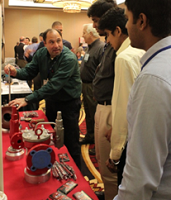Introducing Innovative Technology to Valve and Actuator Industries
In deeply conservative industries, the introduction of new products or technology is subject to a particular circular logic.
#automation #actuators
A Matter of Perspective
The perspective of the manufacturer often differs significantly from that of the user.
Manufacturers are more oriented towards the product. Ideas often come from engineering design and development teams with varying levels of input from sales teams. In theory, field sales teams should be the customer interface for product developments and improvements. But manufacturers are motivated to produce unique, profitable products that can strengthen their market position for enhanced sales and profit.
Even practical and needed solutions may be tested and verified against criteria that have little to do with real-life applications. A technology may work well in laboratory tests but, when exposed to real world conditions not anticipated in the lab, may fail miserably.
The end-user’s perspective is far more pragmatic towards new technology. Do the benefits justify a change from a proven technology in terms of cost? Do the benefits justify a change from a proven technology in terms of plant reliability? Can these benefits be verified?
The power industry is a good example of sensible conservatism at work. This attitude is probably rooted in the history of the industry. The beginnings of power plant design can be found in marine propulsion. When steam power replaced sail, the wellbeing of a vessel, its crew and passengers depended on the reliability of the mechanical steam propulsion system. The cautious approach to marine reliability migrated over to the electric power generating industry. The result is that, even today, new technologies are often viewed with caution.
Communicate Benefits
In recent years we have seen a remarkable change in our daily lives due to technology; a lot of these changes are driven by electronics and software. The pace of consumer technology change is frantic, but the change is much more moderate in the valve and actuator industries despite the fact that many companies are delivering new and innovative products.
How can they convince end users to have the confidence to try these new ideas? It may seem simplistic, but the manufacturer needs to have a clear understanding of the user benefits that the new product delivers. Only then can a clear message be communicated to the relevant marketplace.
Once the message is chosen, then the form and delivery channel of that message can be decided.
For example, a new valve design that withstands erosive media could deliver significant benefits to severe service applications in several user industries. Or a new design of precision actuator could improve fine control of liquid metering in a process. Exactly how these hypothetical products are presented to the market will dictate the response and their subsequent success.
The support material to communicate this message could include descriptive literature, videos, technical articles, application examples, testimonials, internal test data and any other tool that adds to the credibility of the product.
The options to deliver these items have expanded and are now relatively instantaneous, inexpensive and global. As well as traditional print media, which still has a strong role to play, there is a whole spectrum of electronic media, including online magazines, user forums, YouTube and webinars. It is wise also not to forget more traditional communications methods such as trade shows and product presentations.
Build Credibility
A well-crafted marketing communication program can ensure that the product’s application and benefits to the customer are well understood. However, this may all come full circle when the customer says “show me where I can see this new technology in operation.”
Building the critical mass of credibility for a product with new technology may take time. But some steps can help significantly.
In the development phase, manufacturers can work with an end user for placement of beta test units. One benefit of this is that the end user feels his or her input has a bearing on the design or development of the product and a sense of ownership is engendered.
When the test unit is in field operation, it is generating a track record for the product; if well monitored, this can be used as credible field experience. The more beta units testing in target industries, the better.
As an incremental step, certain technologies can be tested in existing products. This is a simple way to gain field credibility. For example, a new seat material or design could be tested in an existing valve body. Or a new torque sensor for an actuator could be tested in an already proven production actuator.
In both these examples, good documentation and site references would support the field experience and provide marketing tools to describe the application of the technology.
In certain regions of the world, some customers like to try a new technology. A project manager could enhance his or her own reputation if the project sees a significant benefit—but this is rare. The more common scenario requires a coordinated professional approach to communicating the advantages of new technology and products, even for companies with solid brand name recognition.
Chris Warnett is president of CPLloyd Consulting Inc., Rochester NY. He has more than 38 years of engineering, sales and marketing experience in valves and automation. Reach Warnett at chris@cplloydconsulting.com or 585.298.6239.
This article originally appeared in the Summer 2014 issue of Valve User Magazine, published by the British Valve & Actuator Association. It is reprinted here with the permission of BVAA.
RELATED CONTENT
-
Introduction to Pressure Relief Devices - Part 1
When the pressure inside equipment such as boilers or pressure vessels increases beyond a specified value, the excess pressure may result in a catastrophic failure.
-
The Dos and Don’ts of Isolating Pressure Relief Valves
Typically, isolation valves are used to block off a pressure safety valve (PSV) from system pressure, so that maintenance on the valve or related equipment can be conducted without a shut down.
-
Regulators versus Control Valves: What’s the Best Fit?
The combination of North American shale fields that continue to fuel high levels of new domestic oil and gas projects and ongoing global efforts means the need for efficiency in instrumentation selection has never been higher.









 Unloading large gate valve.jpg;maxWidth=214)


